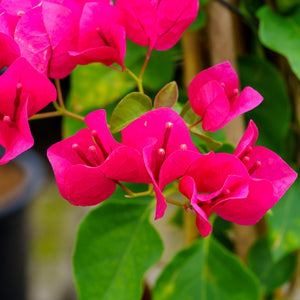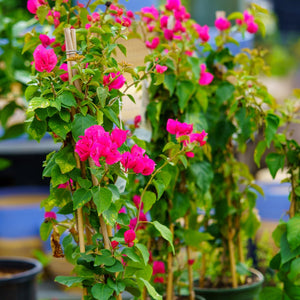The Bougainvillea Guide
Bougainvillea, with its vibrant, papery bracts and lush foliage, brings a touch of tropical splendor and dramatic color to any garden or outdoor space. Known for their striking blooms and vigorous growth habit, Bougainvillea plants are perfect for adding vertical interest and a burst of color to trellises, walls, and containers. These plants are admired for their ability to thrive in warm climates and their minimal maintenance requirements. Whether you're aiming to enhance your garden's visual appeal, create a show-stopping display, or add a unique element to your space, Bougainvillea offers a captivating and versatile solution. Explore our Bougainvillea Guide to learn more about cultivating and caring for these stunning plants, and discover how to incorporate them into your garden for lasting beauty and enjoyment.
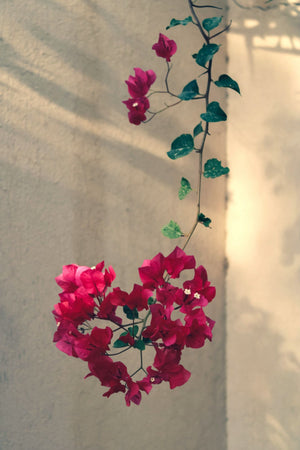
About Bougainvillea
Bougainvillea is a genus of flowering plants in the Nyctaginaceae family, comprising about 18 species. These plants are native to South America, including countries like Brazil, Peru, and Argentina. The name "Bougainvillea" honors the French explorer Louis Antoine de Bougainville, who first documented the plant in the 18th century. Bougainvillea plants are characterized by their woody, thorny vines and clusters of brightly colored bracts, which are often mistaken for flowers. The true flowers are small and typically white or yellow, nestled within the vibrant bracts that come in shades of magenta, purple, red, orange, pink, and white. The foliage is lush and green, with some varieties exhibiting variegated leaves. Bougainvillea plants are evergreen in warm climates but can behave as deciduous plants in cooler regions.
Bougainvillea glabra is known for its smooth leaves and thornless stems, making it popular for its ease of care and resilience. Bougainvillea spectabilis features larger bracts and a more vigorous growth habit, known for its thorny stems and large, showy bracts. Bougainvillea ‘Barbara Karst’ is a hybrid variety prized for its vibrant magenta-red bracts and vigorous growth.
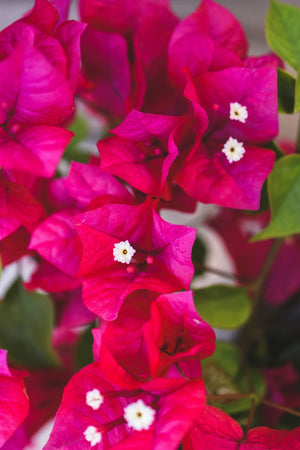
Planting Bougainvillea
Bougainvillea plants require specific planting conditions to ensure their successful establishment and flourishing growth. Here are some essential guidelines for planting and caring for Bougainvillea:
Soil: Bougainvillea prefers well-draining soil that is moderately fertile. A sandy or loamy soil works best. Ensure the planting site is free from heavy clay or waterlogged conditions, which can cause root rot. Adding organic matter like compost can improve soil fertility and drainage.
Light: Bougainvillea thrives in full sun. Choose a location with at least six hours of direct sunlight per day for optimal blooming. In cooler climates, a south-facing wall or structure can provide additional warmth and support for growth.
Watering: Bougainvillea requires regular watering during the first growing season to establish a strong root system. Once the plants are established, they are highly drought-tolerant and require minimal watering. Avoid overwatering, as this can lead to root rot. Allow the soil to dry out between waterings to prevent waterlogged conditions.
Planting Depth: Plant Bougainvillea at the same depth as it was growing in its pot or nursery container. Space the plants 3-5 feet apart to allow for proper air circulation and growth. When planting in the ground, dig a hole twice as wide and the same depth as the root ball to encourage root spread.
Mulching: Apply a layer of organic mulch, such as compost or shredded leaves, around the base of the plants to retain moisture, suppress weeds, and regulate soil temperature. Avoid covering the stems directly, as this can lead to rot.
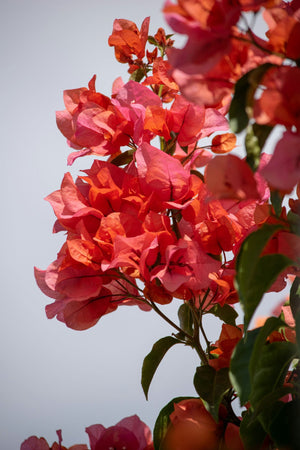
Care for Bougainvillea
Bougainvillea plants require specific care to ensure their optimal growth and health. Here are some general guidelines for the care of Bougainvillea:
Watering: Water Bougainvillea regularly during the first growing season to help establish a strong root system. Once established, the plants are drought-tolerant and require minimal watering. Water deeply and infrequently, allowing the soil to dry out between waterings.
Fertilizing: Bougainvillea benefits from a balanced, slow-release fertilizer applied in the spring and mid-summer. Follow the recommended dosage on the product label. Avoid over-fertilizing, as this can lead to excessive foliage growth at the expense of bracts.
Pruning: Prune Bougainvillea regularly to maintain its shape and encourage new growth. Remove spent bracts and any dead or damaged stems. Light pruning throughout the growing season helps promote continuous blooming. Major pruning should be done in late winter or early spring before new growth begins.
Pests and Diseases: Bougainvillea is relatively pest-resistant but can be susceptible to issues such as aphids, mealybugs, and scale insects. Inspect your plants regularly and treat any infestations promptly with appropriate organic or chemical controls. Maintain proper spacing and air circulation to reduce the risk of diseases.
Support: Bougainvillea is a climbing vine and may require support to grow vertically. Use trellises, arbors, or fences to provide the necessary structure for the plant to climb. Secure the vines gently to the support structure to avoid damaging the stems.
Winter Care: In colder climates, Bougainvillea should be grown in containers that can be moved indoors during the winter. Place the containers in a bright, sunny spot and reduce watering to keep the soil on the drier side. If grown in the ground, protect the roots with a thick layer of mulch and cover the plant with frost cloth during cold spells.
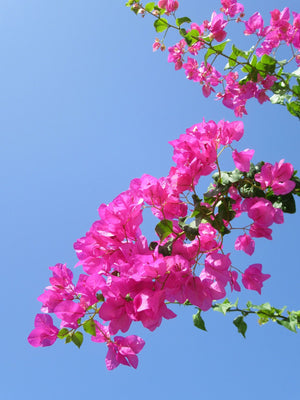
How To Use
Bougainvillea offers versatility and can be utilized in various ways to enhance your garden and outdoor spaces. Here are some recommendations based on their characteristics:
Trellises and Arbors: Bougainvillea's climbing habit makes it perfect for trellises and arbors. Plant them at the base of these structures and train the vines to grow upward, creating a stunning vertical display of color.
Walls and Fences: Grow Bougainvillea along walls and fences to add a burst of color and soften hardscapes. The vibrant bracts will create a striking backdrop and enhance the visual appeal of your garden.
Containers and Hanging Baskets: Bougainvillea can be grown in containers and hanging baskets, making them a versatile choice for patios, balconies, or small gardens. Choose a large container with good drainage and place it in a sunny spot to enjoy the blooms up close.
Ground Cover: In warmer climates, Bougainvillea can be used as a ground cover to fill large areas with color. Plant them in drifts or clusters to create a vibrant carpet of bracts.
Hedges and Screens: Use Bougainvillea to create colorful hedges and privacy screens. Plant them in a row and allow the vines to grow together, forming a dense, flowering barrier.
Espalier: Train Bougainvillea to grow flat against a wall or fence using the espalier technique. This method not only saves space but also creates a unique and decorative display.
Conclusion
Bougainvillea is a captivating and versatile addition to any garden or outdoor space. With their vibrant bracts, vigorous growth, and minimal maintenance requirements, Bougainvillea plants bring a touch of tropical splendor and dramatic color to your environment. Their adaptability to various growing conditions and ease of care make them a favorite among gardeners of all levels. By following proper planting and maintenance techniques, you can fully harness the potential of Bougainvillea to enhance your garden, creating a lasting impact.
Whether you seek to create stunning vertical displays, add visual interest to walls and fences, or enjoy their beauty in containers, Bougainvillea can fulfill a variety of roles in your landscape design. Place them individually to highlight their unique bracts, or combine different species and varieties for a dynamic and visually appealing display. Bougainvillea's resilience and adaptability also make them ideal for ground covers and privacy screens.
Beyond their ornamental value, Bougainvillea plants contribute to the overall beauty and charm of your garden ecosystem. With their enduring beauty, versatility, and ecological significance, Bougainvillea plants bring delight and natural allure to your outdoor environment, enriching your gardening experience and enhancing the overall beauty of your landscape.

